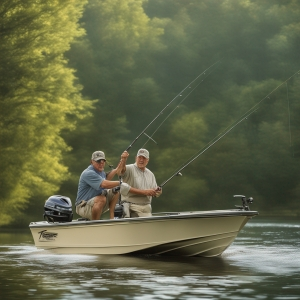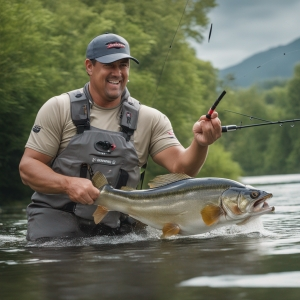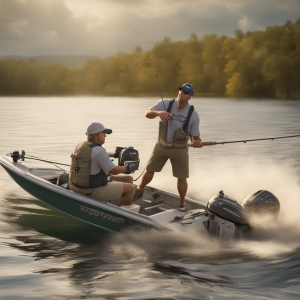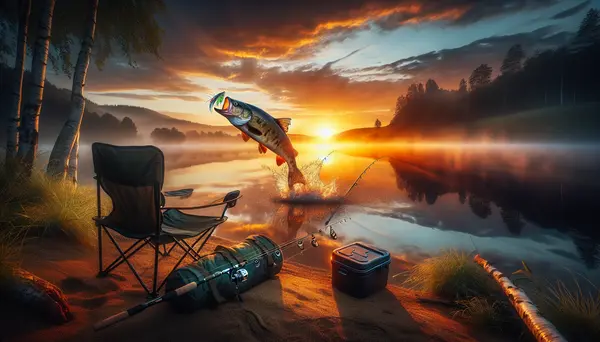Table of Contents:
In the world of angling, there are few things more exhilarating than topwater fishing. This method, which involves luring fish from the water's surface, can deliver both a visual thrill and a rewarding haul. Whether you're a seasoned angler or new to the game, understanding the ins and outs of topwater fishing can greatly enhance your fishing experience. This article aims to provide an introduction to this unique style of fishing and highlight the techniques that will help you succeed.
Introduction to Topwater Fishing
Topwater fishing is an exciting and adrenaline-fueled style of angling. It's the practice of drawing fish out from their underwater habitats to attack bait positioned on the water's surface. The sheer visual spectacle of a fish breaking the water's surface for your bait makes topwater fishing particularly thrilling.
This method is especially effective during warmer weather when fish are often found feeding near the surface. However, it's not the ease of topwater fishing that makes it so compelling. It's the heart-thumping, eye-widening moments when a fish breaches the water, making a splash that can be seen and heard from a distance.
While topwater fishing might seem simple, there's a lot more to it than meets the eye. Patience, strategy, and the right set of tools are essential ingredients for a successful topwater fishing experience. In the following sections, we'll delve deeper into the techniques and strategies of topwater fishing that can transform an ordinary fishing trip into an unforgettable adventure.
Why Topwater Fishing is Exciting
The excitement around topwater fishing largely stems from its visual appeal. Unlike other forms of fishing where the action occurs beneath the water surface, topwater fishing provides an opportunity to witness the catch process in full view. The thrill lies in watching a fish spot the lure, follow it, and finally launch an attack. It's almost like a game, where you, as the angler, get to see your tactics either pay off with a successful catch or miss the mark.
Another exciting aspect of topwater fishing is the element of unpredictability. Each attempt at luring a fish brings with it an air of mystery and suspense. This sense of unpredictability adds a level of thrill you might not experience in other fishing methods where the process is mostly felt rather than seen. This anticipation and unpredictability make topwater fishing not just a serene bonding experience with nature, but also a heart-thumping activity that keeps anglers on the edge of their seats.
Pros and Cons of Topwater Fishing
| Pros | Cons |
|---|---|
| Exciting visual spectacle as fish leap out of the water | Requires precise timing and speed |
| Larger fish tend to be caught closer to the surface | Fishing on the surface exposes you to weather elements |
| Accessible for beginners with simple techniques | Topwater lures can be more expensive |
Understanding the Right Techniques in Topwater Fishing

When it comes to topwater fishing, understanding and mastering the right techniques is crucial. The first step is choosing the correct lure. Topwater lures are available in a variety of designs, sizes, and colors. These include poppers, chuggers, and stick baits—each ideal for specific conditions and species. Poppers, with their concave or slanted noses, are perfect for making a splash that mimics a prey's movement. On the other hand, stick baits mimic injured fish, triggering the predator instinct in fish.
Secondly, the casting technique used for topwater fishing differs from other forms. Instead of a simple straight cast, topwater fishing often requires more diverse movements. You might need to twitch, jerk, or walk the bait to entice fishes towards it. Make sure to practice these movements to perfect your lure presentation. The right bait movement can make the difference between a successful catch and an empty hook.
The third important topwater fishing technique is striking at the right time. One of the biggest mistakes beginners make in topwater fishing is striking too early. When you see a fish approaching your bait, let it take the lure, disappear beneath the surface, then set the hook with a solid upward swing. Patience is key to landing a successful topwater catch.
Lastly, topwater fishing is heavily dependent on weather and lighting conditions. Topwater lures are most effective in low-light conditions such as early morning or late afternoon. These are the times when fish are most likely to be near the surface. Apart from the time of day, water temperature and clarity can also affect topwater fishing. Warmer, clearer waters generally increase your chances of a successful catch.
Essential Gears for Topwater Fishing
When it comes to the tools of the topwater angling trade, choosing the right gears can mean the difference between success and frustration. Gone are the days when any old rod, reel, and line would suffice for a good day of fishing. In today's increasingly specialized world of angling, the need for gears adapted specifically to the task at hand, such as topwater fishing, has become paramount.
One of the most critical components of topwater fishing gear is the rod. A longer rod will allow you to cast farther distances and control your lure's movements better. It's recommended to use a rod of 7 to 7.5 feet long for topwater angling.
Also crucial is the reel. It should be smooth and have a quick retrieve to keep the tension and handle the explosive bites. A quality reel would ensure you have the needed strength and line capacity to handle the fight when you hook a strong fish.
Your fishing line is yet another vital piece of your topwater fishing gear set. Braided lines are an excellent choice for topwater fishing. They are exceptionally strong, offer increased casting distance, and their lack of stretch provides a higher hooking power.
Of course, no discussion of topwater fishing gear would be complete without mentioning the lures. As previously stated, topwater lures come in a variety of styles, including poppers, chuggers, and stick baits. The selection of lure should be based on the type of fish you're targeting and the specific conditions in your fishing environment. Always have a variety of lures on-hand to test out and adapt to the fish's preferences.
Lastly, don't forget about the importance of personal safety gear. Always ensure you have a life jacket, first aid kit, and suitable clothing to protect yourself from the elements and any unanticipated hazards.
Understanding and investing in the proper gear is a significant step towards mastering the art of topwater fishing and maximizes your chances of a successful and enjoyable angling experience.
Best Times for Topwater Fishing

Finding the right time for topwater fishing is essential for the best results. Although this method of angling can be practiced at any time, certain conditions are more favorable for a successful catch. Fish are cold-blooded creatures, so their activity levels fluctuate with the changing temperatures. Knowing this, we can optimise our fishing schedules.
Early morning, just after sunrise, is one of the most productive times to do topwater fishing. The water is usually calm, and the light is low. At this time, most fish species come up to the surface to hunt for their first meal of the day. Considering this, early birds will have a greater chance of striking it lucky on the water.
The late afternoon into the evening is another ideal time. As the day cools off, fish again start to feed actively near the surface. The fading light at dusk provides excellent camouflage for your lures, making them irresistible to the fish.
Topwater fishing can also be reasonably successful during the night, especially under a full moon. The fish, attracted by the surface movement, could mistake your lure for prey.
However, remember that the behavior of fish varies with different species and locations. It might take some trial and error to find what works best for your specific situation.
Quick Tips for Beginners in Topwater Fishing
Starting out with topwater fishing can seem challenging but it's all about learning and adapting to this technique. Equip yourself with the following tips to get a jump-start and make your rookie days more fruitful.
1. Choose the right location: Locations with shallow water or defined structures like docks or vegetation make for excellent spots for topwater fishing. The trick is to find where the fish might be hiding or feeding.
2. Observe and learn: Pay close attention to the water surface. Look for signs of feeding fish, such as ripples or jumping baitfish. This will help you understand where to cast your lure for effective results.
3. Take weather patterns into account: Weather can have a big impact on fish behavior. Overcast days can extend the topwater bite, while a steady barometric pressure often means good fishing conditions.
4. Practice casting: Accurate casting can ensure your lure lands exactly where you want it, increasing your chances of a successful catch. Practice makes perfect!
5. Seek professional guidance: If possible, hit the water with an experienced angler or enlist the help of a professional guide on your first few trips. They can provide you with invaluable firsthand knowledge that you can't learn from a book.
Remember, patience is a virtue in angling. Every missed strike or lost fish is a learning opportunity. Enjoy the journey as a beginner and know that with time, you’ll hone your topwater fishing skills.
Conclusion: Enjoy the Thrill of Topwater Fishing!

Topwater fishing offers both seasoned anglers and beginners an unforgettable angling experience. Its unique appeal lies in the visual spectacle it provides, elevating the traditional fishing experience into a thrilling game of anticipation and skill.
Mastering topwater fishing techniques such as correct lure selection, casting, timing your strike, and understanding how weather conditions impact the behavior of fish, can elevate your angling skill set to a new level.
So why wait? Gear up, hit the waters and get ready to feel the rush and reel in some impressive catches. Here's to memorable stories of the one that leaped, splashed, and didn't get away!
Topwater Fishing: Essential Techniques and FAQs
What is topwater fishing?
Topwater fishing is a technique where fishing lures are designed to float and move above the water surface. This creates a visual spectacle for predators below the water surface which are enticed to leap out of the water to catch the bait.
Why is topwater fishing exciting?
In topwater fishing, the excitement comes from seeing the fish leap out of the water and strike at the lure on the surface. This visual aspect of fishing brings a more interactive and thrilling experience to the angler.
When is the best time for topwater fishing?
The best time for topwater fishing is usually early in the morning or late in the evening when the water is calm and the light is low.
What are the techniques of topwater fishing?
Techniques can vary greatly depending on the type of lure used. Some common methods include the walk the dog, poppers or chugger, prop bait, and twitch bait techniques.
What species of fish can you catch with topwater fishing?
Some species that are often caught on topwater lures include bass, trout, musky, and pike among others.







